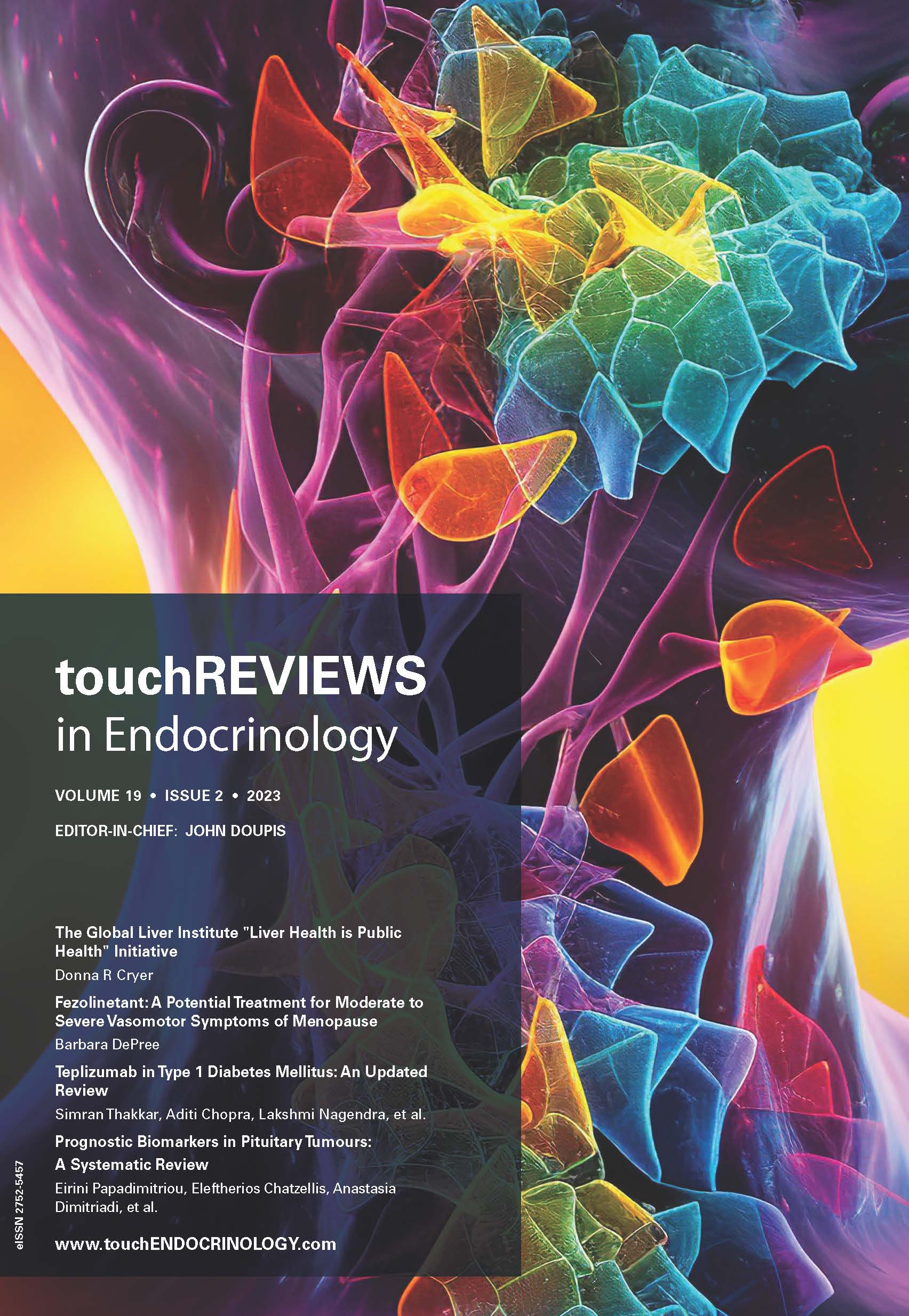EUROPEAN ENDOCRINOLOGY – VOLUME 7 ISSUE 2 – WINTER 2011
Foreword
Welcome to the latest edition of European Endocrinology, where, as usual, you will find a broad spectrum of topics addressed in the selection of review articles contained within. The articles have been chosen due to their relevance to clinical practice, to our constantly-evolving field of research and to our endocrinology community overall. Our discipline is […]
Editor
Hyponatraemia is by far the most common electrolyte imbalance found in hospital inpatients,1 and patients with symptomatic hyponatraemia have a vastly increased mortality compared with normonatraemic controls.2 Therefore, it is essential that hyponatraemic patients receive effective and targeted therapy. However, hyponatraemia has many pathophysiological causes, each of which needs to be managed differently, making accurate […]
Diabetes Pathophysiology
A Thesis in Berlin in the 19th Century On 18 February 1869 in Berlin, a 22-year-old student of the famous pathologist Rudolf Virchow presented his thesis for an MD degree at the Friedrich Wilhelms University entitled ‘Beiträge zur mikroskopischen Anatomie der Bauchspeicheldrüse’ or ‘Contributions to the microscopic anatomy of the pancreatic gland’ (see Figure 1). […]
Diabetes Management
The Need for New Insulin Analogues Diabetes is associated with several serious chronic complications, including nephropathy, retinopathy, neuropathy and most importantly cardiovascular disease, impacting quality of life and health costs and decreasing survival. These complications can be reduced both in type 1 and type 2 diabetes patients, by obtaining an adequate glycaemic control. However, this […]
Blood Glucose Monitoring
Glycaemic Control is a Challenge in Diabetes Large controlled clinical trials have demonstrated that intensive management of glycaemia and other diabetes risk factors can significantly decrease the development and/or progression of macrovascular and microvascular disease.1–4 Achieving optimal glycaemic control requires a high level of daily self-management.
Cardiovascular Risk
Diabetes mellitus, a metabolic disorder defined by fasting glucose concentration ≥7.0 mmol/l or by glycated haemoglobin ≥6.5 %,1 represents an established risk factor for coronary artery disease;2,3 the number of people who have diabetes mellitus is predicted to rapidly rise in coming years,4 due to the increased incidence of type 2 diabetes.
Non-alcoholic Fatty Liver Disease
Non-alcoholic fatty liver disease (NAFLD), actually the most common cause of chronic liver injury, comprises a disease spectrum ranging from simple steatosis to non-alcoholic steatohepatitis (NASH), advanced fibrosis and cirrhosis.1,2 NAFLD is defined as an accumulation of fat, mainly triglycerides (TG), in hepatocytes exceeding 5–10 % of the liver weight and this in the absence […]
Pituitary Disorders
Growth hormone deficiency (GHD) in adults is characterised by alterations in body composition, carbohydrate and lipid metabolism, bone mineral density, cardiovascular risk profile and quality of life.1 Treatment with GH replacement has been shown to improve some, but not all, of these abnormalities.2 In contrast, untreated GHD is associated with increased morbidity and mortality that […]
Thyroid Disorders
Functions of B Cells and Their Role in Autoimmune Disease Although B lymphocytes are known to contribute to the pathogenesis of autoimmune disease through autoantibody production,1 many recent studies of B-cell function carried out in experimental animal models have shown that they possess other functions such as CD4+ T-cell activation2 and control of T-cell function […]
Male Endocrinology
The impairment of vascular endothelium is an early event in the development of diseases that may later become clinically overt, such as local and systemic atherosclerosis, myocardial infarction, cerebral ischaemia and erectile dysfunction. Normal vascular endothelium is essential for the synthesis and release of substances affecting vascular tone, cell adhesion and the homoeostasis of clotting […]
Case Reports
Biphasic insulin aspart 30 (BIAsp 30) is a premix insulin analogue containing 30 % rapid-acting insulin aspart (IAsp) and 70 % protamineretarded IAsp. With mealtime administration, the rapid-acting IAsp component provides coverage for postprandial glucose (PPG) while the protaminated component provides intermediate coverage for basal glycaemic control. Therefore, premix insulin analogues, such as BIAsp 30, […]
Individuals diagnosed with type 2 diabetes will typically be advised about lifestyle modifications to improve their diet and increase their physical activity and may be prescribed one or more oral antidiabetic drugs (OADs) to improve their glycaemic control.1 However, many patients will require insulin initiation as lifestyle changes and OADs are no longer able to […]
Premix insulin analogues such as biphasic insulin aspart 30 (BIAsp 30) offer advantages over biphasic human insulin 30 (BHI 30) in terms of faster absorption, higher peak concentrations, a more rapid and pronounced glucose-lowering effect and comparable duration of action of the basal component.1,2
Premix insulin analogues such as biphasic insulin aspart 30 (BIAsp 30) offer a convenient and simple way to intensify basal insulin therapy once the basal insulin is no longer able to control glycosylated haemoglobin (HbA1c).

Trending Topic
We are pleased to present the latest issue of touchREVIEWS in Endocrinology, which offers a timely and thoughtprovoking collection of articles that reflect both the continuity and evolution of diabetes and metabolic disease research. In an era where technology, public health priorities and clinical paradigms are shifting rapidly, this issue highlights the importance of evidence-based […]
Journal Archive
touchREVIEWS in Endocrinology (previously European Endocrinology) is a peer-reviewed, free-to-access, bi-annual journal comprising review articles, case reports, editorials, special reports and original research. It features balanced and comprehensive articles written by leading authorities, addressing the most important and salient developments in the field of endocrinology.
Latest articles videos and clinical updates - straight to your inbox
Log into your Touch Account
Earn and track your CME credits on the go, save articles for later, and follow the latest congress coverage.
Register now for FREE Access
Register for free to hear about the latest expert-led education, peer-reviewed articles, conference highlights, and innovative CME activities.
Sign up with an Email
Or use a Social Account.
This Functionality is for
Members Only
Explore the latest in medical education and stay current in your field. Create a free account to track your learning.






